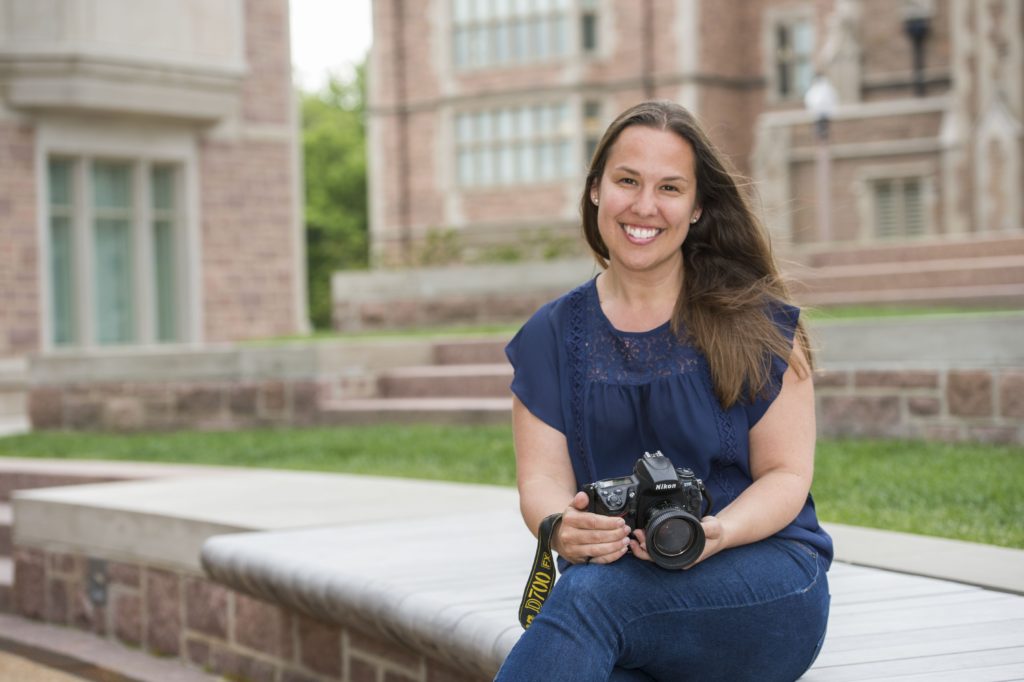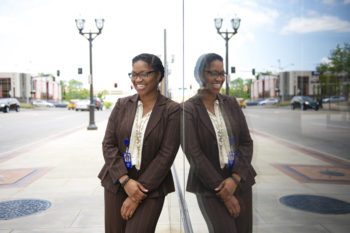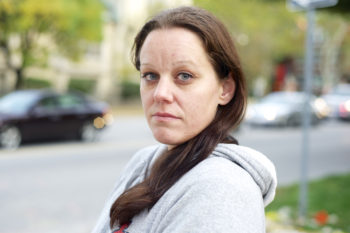Through her photography, Lindy Drew engages and tells the stories of strangers

Lindy Drew, masters of social work and public health student, outside Hillman Hall. Drew, a long time photographer, is a co-founder of the Humans of St. Louis project. Joe Angeles/WUSTL Photos
Humans of Washington University
“I was looking for an art project on the side to do something creative and take a break from studying a bit. A friend introduced me to Caroline Fish, MSW ’14, who had an idea for a community art initiative. She asked, ‘Have you ever heard of Humans of New York?’ At that time, I hadn’t. But I started looking at Brandon Stanton’s work and thought it was such a vibrant project. ‘Humans of’ pages had popped up all over the world, but St. Louis didn’t have one.
“So, together we started going out on the street to interview and photograph strangers. When we launched the site, we put out three or four stories a day and had 300 or 400 likes a day. It was really refreshing to walk up to people in St. Louis and just start a conversation with them about life, love or what this city means to them. And it was fun to watch the audience grow, comment and share these micro-stories about everyday people from around here. Before I came here for school, I Googled ‘St. Louis’ and the majority of photos were of the arch. I’m excited that now there’s a body of work that’s accessible so anyone can see what St. Louis looks like from the perspective of people that live here.”
~ Lindy Drew, masters of social work and public health student at the Brown School
Photography is in Lindy Drew’s blood, but so is the notion of making the world a better place by connecting people with information and services they need to thrive.

“What are you looking forward to?”
“Living. When I was 30 I got diagnosed with lymphoma. All of my goals changed. Before, I was like, I want to be married by 32. I want to have kids by 34. Now I’m in my fourth year of remission. I put everything else on the backburner. All of my goals of trying to do things by certain timelines shifted. My number one priority is staying alive right now. I have some things I want to do but my main thing is just living.”
Drew, a documentary street photographer whose work has been published in the St. Louis Post-Dispatch, St. Louis Magazine, the Riverfront Times and more, is a founding member of the Humans of St. Louis (HOSTL) project. Modeled after the highly successful Humans of New York, HOSTL is a Facebook page dedicated to telling the stories of the people of St. Louis, one photo and one story at a time through brief snapshots of their lives. After graduating with a degree in biology from the University of Arizona in 2000, Drew traveled through Latin America for three years, immersing herself in the culture, teaching youth digital photography and sharing people’s stories through her photographs.
“I was working in Phoenix as a team coordinator at Casa de Sueños, a group home for unaccompanied undocumented minors,” said Drew, a Phoenix native. “We provided temporary housing and reunification services for teenagers who illegally crossed the U.S.–Mexico border looking for their families that live here. After a few years of working with such a resilient population, it was time to go back to school to further my education.”
She wanted to learn more about social work and public health to be able to help vulnerable populations on a larger scale.
“A handful of friends I met while volunteering with at-risk youth in Chile had graduated from the Brown School,” Drew said. “So I became more familiar with the dual degree program through women I already shared interests with. From the way the Brown School reached out to me during my application process, and throughout these three years of growth with the help of faculty and staff, the Brown School was the best choice from the get go.”

“If there was one hurt you could take away, what would it be?”
“My child was five months old when he died of SIDS. So that’s been my biggest upset. I got a letter from the coroner and it said, ‘We’re very sorry for your loss and we’re even more sorry that we can’t give you an explanation for what happened. But we can tell you that it’s obvious this child was very well taken care of.’ There isn’t any way to explain it. It just happens. And when you can’t figure out the cause of death, there’s so much confusion. I started doing ecstasy. Ate 5-10 pills every Saturday for a year and a half just to be numb. I’m just getting myself out of it. I had all the time in the world to sit around and feel sorry for myself. And now I’m thankful to be alive.”
The Humans of St. Louis project has allowed Drew to layer her social work and public health education with documentary photography by connecting the broader community through the art of storytelling.
It has also widened her view of St. Louis, as she winds through the streets and talks to strangers from neighborhood to neighborhood.
“The project has taught me that you can cross the racial divide on a bike with your camera and a bit of genuine curiosity,” Drew said, “and it’s taught me that celebrating commonalities and respectfully shining a spotlight on differences can unify. People appreciate platforms like this to be able to engage in more dialogue together. Everyone has a story. If you just ask, it’s surprising how much people will share.”
by Neil Schoenherr